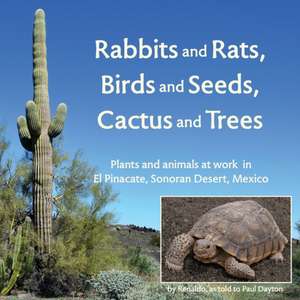Rabbits and Rats, Birds and Seeds, Cactus and Trees
Autor Paul Daytonen Limba Engleză Paperback – 17 aug 2017
| Toate formatele și edițiile | Preț | Express |
|---|---|---|
| Paperback (2) | 56.66 lei 3-5 săpt. | |
| Dayton Publishing LLC – 17 aug 2017 | 56.66 lei 3-5 săpt. | |
| LIGHTNING SOURCE INC – 16 aug 2017 | 61.33 lei 17-23 zile | |
| Hardback (1) | 113.79 lei 6-8 săpt. | |
| Dayton Publishing LLC – 22 iul 2019 | 113.79 lei 6-8 săpt. |
Preț: 56.66 lei
Nou
Puncte Express: 85
Preț estimativ în valută:
10.84€ • 11.35$ • 8.97£
10.84€ • 11.35$ • 8.97£
Carte disponibilă
Livrare economică 17-31 martie
Preluare comenzi: 021 569.72.76
Specificații
ISBN-13: 9780997003253
ISBN-10: 0997003251
Pagini: 34
Dimensiuni: 216 x 216 x 3 mm
Greutate: 0.1 kg
Editura: Dayton Publishing LLC
ISBN-10: 0997003251
Pagini: 34
Dimensiuni: 216 x 216 x 3 mm
Greutate: 0.1 kg
Editura: Dayton Publishing LLC
Notă biografică
Renaldo, a Sonoran desert tortoise, lives on the top of Mount Salvatierra in the El Pinacate Biosphere Reserve and World Heritage Site in Sonora, Mexico, where he has a good view of the changes that happen in his desert ecosystem over several decades. Lacking fingers, a camera and a computer, he recruited Paul Dayton, a visiting biologist, to tell his story. Paul Dayton grew up in the Sonoran Desert, in Tucson, Arizona. He received his B.S. degree from the University of Arizona and his Ph.D. in Zoology from University of Washington. He is a biological oceanographer and ecologist at Scripps Institution of Oceanography in La Jolla, California. Dayton has worked in Benthic Ecology, Marine Conservation & Policy, Evolution & Natural History, and General Ecology. During his 35-year career at Scripps, Dayton has researched coastal Antarctic habitats and rocky-shore and kelp habitats worldwide in order to better understand marine ecosystems. He has also documented the environmental impacts of overfishing, water reclamation, and phenomena such as El Niño on coastal ecology. Among other honors, Dayton is the only person to win both the George Mercer Award (1974) and the WS Cooper Award (2000) from the Ecological Society of America. In 2002 he received the Scientific Diving Lifetime Achievement Award from the American Academy of Underwater Sciences; in 2004 he was honored with the Edward O. Wilson Naturalist Award from the American Society of Naturalists, and in 2006 he was the first recipient of the Ramon Margalef Prize in Ecology, awarded by a jury of scientists representing Catalonia, the European Union, and the international ecology community.
